
A wargame is a strategy game in which two or more players command opposing armed forces in a simulation of some military operation. Wargaming may be played for recreation, to train military officers in the art of strategic thinking, or to study the nature of potential conflicts. Many wargames re-create specific historic battles, and can cover either whole wars, or any campaigns, battles, or lower-level engagements within them. Many simulate land combat, but there are wargames for naval and air combat, as well.

Avalon Hill Games Inc. is a game company that publishes wargames and strategic board games. It has also published miniature wargaming rules, role-playing games and sports simulations. It is a subsidiary of Hasbro, and operates under the company's "Hasbro Gaming" division.
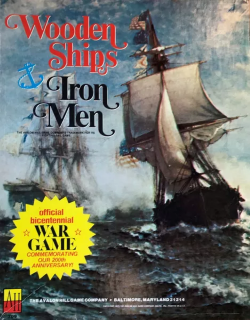
Wooden Ships and Iron Men is a naval board wargame simulating naval combat during the Age of Sail that was published by Battleline Publications in 1974, then revised and republished by Avalon Hill the following year.
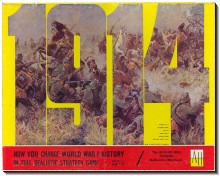
1914 is a board wargame published by Avalon Hill in 1968 that simulates the first few months of World War I on the Western Front.

War at Sea is a strategic board wargame depicting the naval war in the Atlantic during World War II, published by Jedko Games in 1975, and subsequently republished by Avalon Hill in 1976 and more recently by L2 Design Group in 2007.
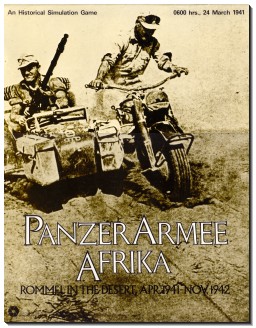
PanzerArmee Afrika, subtitled "Rommel in the Desert, April 1941 - November 1942", is a board wargame published by Simulations Publications, Inc. (SPI) in 1973 that simulates the World War II North African Campaign that pitted the Axis forces commanded by Erwin Rommel against Allied forces. The game was revised and republished in 1984 by Avalon Hill.
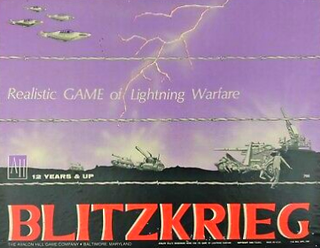
Blitzkrieg is a strategic-level wargame published by Avalon Hill in 1965 that simulates a non-historical attack by one major power against another using the blitzkrieg strategy. It was the first commercial wargame that did not simulate an actual historical battle, and with almost 400 counters, it was a precursor to the "monster" wargames of the 1970s featuring more than a thousand counters.

A hex map, hex board, or hex grid is a game board design commonly used in wargames of all scales. The map is subdivided into a hexagonal tiling, small regular hexagons of identical size.

Jutland is a naval board wargame published by Avalon Hill in 1967 that simulates the Battle of Jutland in the North Sea during World War I. Upon its release, Jutland was commended for its gameplay and mechanics, but criticism surrounded the complex rules and playing time.

Battle of the Bulge is a board wargame published by Avalon Hill (AH) in 1965 that simulates the World War II battle of the same name. General Anthony McAuliffe (ret.), who had been commanding officer at Bastogne during the Battle of the Bulge, was a consultant during the game's development. The game proved popular and sold more than 120,000 copies, but was dogged by criticisms of historical inaccuracies, and was finally replaced by a completely new edition in 1981. A third edition in 1991 was released as part of the Smithsonian American History Series.
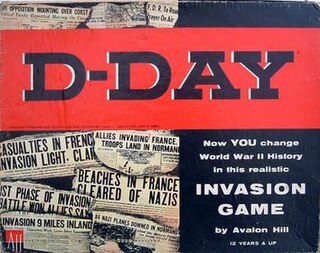
D-Day is a board wargame published by Avalon Hill in 1961 that simulates the six months of the European Campaign of World War II from the Normandy Invasion to the crossing of the Rhine. It was the first wargame to feature the now ubiquitous hex grid map and cardboard counters, and was revised and re-released in 1962, 1965, 1971, 1977 and 1991.

The General (1964–1998) was a bi-monthly periodical devoted to supporting Avalon Hill's line of wargames, with articles on game tactics, history, and industry news. It was the first professionally produced wargaming magazine for the nascent cardboard and hex-map wargaming hobby. Over the years the magazine was variously called The Avalon Hill General, Avalon Hill's General, The General Magazine, or simply General. It was headquartered in Baltimore, Maryland. With the sale of Avalon Hill to Hasbro in 1998 the magazine ceased. Its unofficial heir was Operations Magazine published by Multi-Man Publishing to support the line of Avalon Hill games that remained in print, but that too went out of print in 2010, replaced by Special Ops magazine in 2011.

Tactical wargames are a type of wargame that models military conflict at a tactical level, i.e. units range from individual vehicles and squads to platoons or companies. These units are rated based on types and ranges of individual weaponry. The first tactical wargames were played as miniatures, extended to board games, and they are now also enjoyed as video games.

Alexander the Great is a board wargame first published by Guidon Games in 1971 that simulates the Battle of Arbela in 331 BCE, also known as the Battle of Gaugamela. A revised edition was published by Avalon Hill in 1974. Both editions of the game were notable for having what one critic described as "one of the ugliest maps ever to curse a war game."

Tactics is a board wargame published in 1954 by Avalon Hill as the company's first product. Although primitive by modern standards, it and its sequel, Tactics II, signalled the birth of modern board wargaming for the commercial market. Tactics is generally credited as being the first commercially successful board wargame.
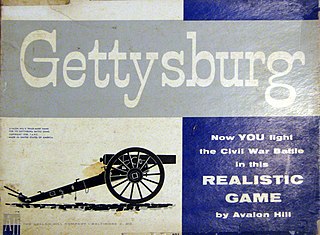
Gettysburg is a board wargame produced by Avalon Hill in 1958 that re-enacts the American Civil War battle of Gettysburg. The game rules were groundbreaking in several respects, and the game, revised several times, was a bestseller for Avalon Hill for several decades.
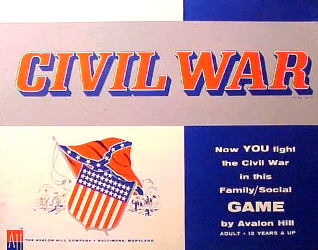
Civil War is an early strategic board wargame published by Avalon Hill in 1961 that simulates the American Civil War. Unlike other games produced by Avalon Hill during this period such as Gettysburg, Civil War did not sell well and was dropped from production two years later.
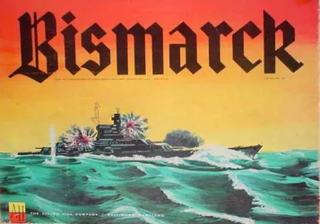
Bismarck is a board wargame published by Avalon Hill in 1962 that simulates the hunt for the Bismarck.

A board wargame is a wargame with a set playing surface or board, as opposed to being played on a computer or in a more free-form playing area as in miniatures games. The modern, commercial wargaming hobby developed in 1954 following the publication and commercial success of Tactics. The board wargaming hobby continues to enjoy a sizeable following, with a number of game publishers and gaming conventions dedicated to the hobby both in the English-speaking world and further afield.
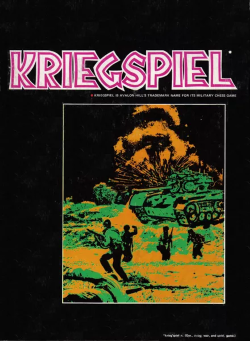
Kriegspiel is a board wargame published by Avalon Hill in 1970 that simulates a hypothetical war between two nations. Although the simple game sold well to new players, it received negative reviews by more experienced gamers.



















